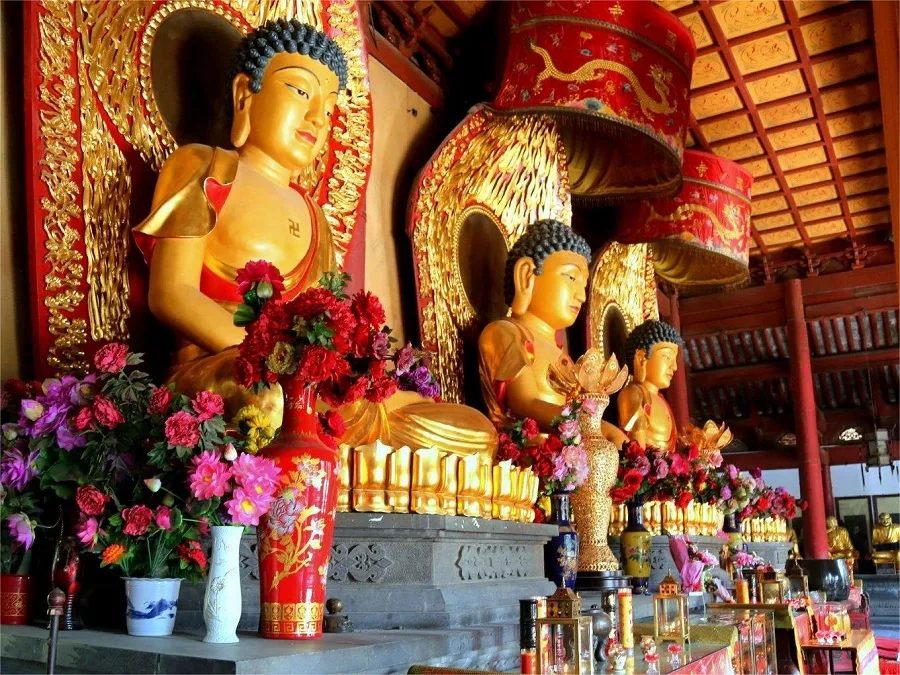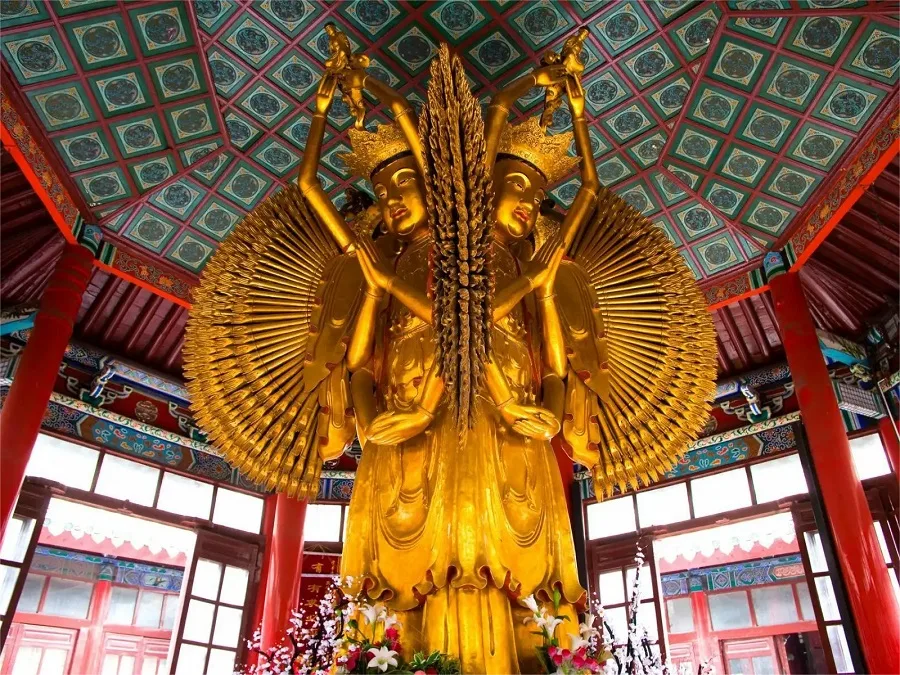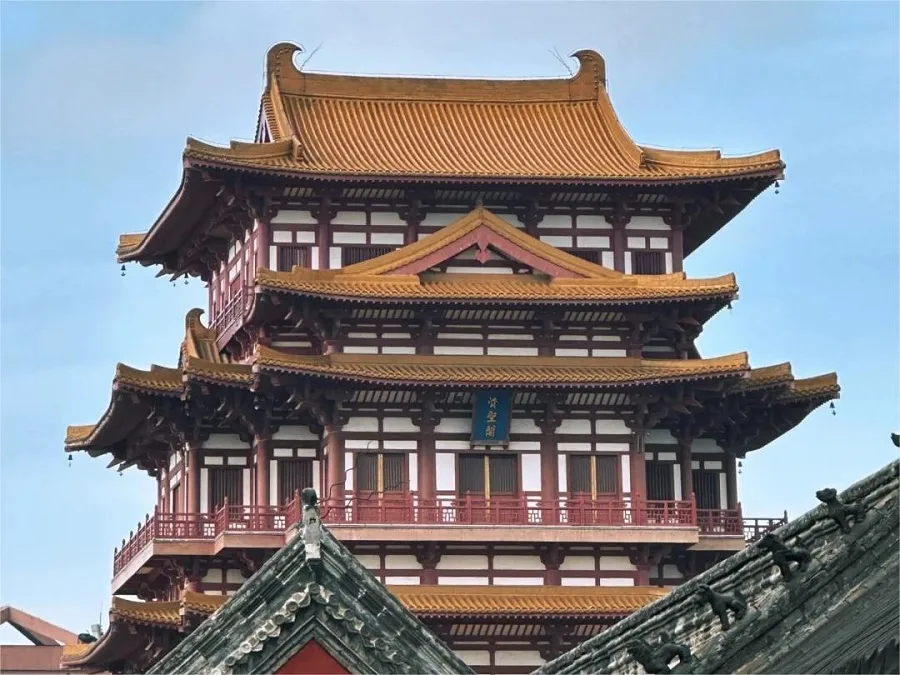Daxiangguo Temple (大相国寺, or Grand Xiangguo Temple), originally named Jianguo Temple, was established in the sixth year of the Tianbao era (555 AD) during the Northern Qi dynasty. In the first year of the Yanhe era (712 AD) of the Tang dynasty, Emperor Ruizong renamed it Daxiangguo Temple to commemorate his ascent to the throne from the title of Prince Xiang, personally inscribing the plaque “大相国寺.” During the Northern Song dynasty, it received great imperial favor and underwent several expansions, becoming the largest temple in the capital city and a center for Buddhist activities nationwide. However, it suffered damage due to wars and floods over the years. It was rebuilt in the tenth year of the Kangxi era (1671 AD) of the Qing dynasty.
Daxiangguo Temple follows the traditional axial symmetry layout of Chinese temples, retaining a strong Ming and Qing architectural style. Facing north and south, it is divided into three courtyards, with main structures including the entrance gate, the Hall of the Heavenly Kings, the Mahavira Hall, the Octagonal Glazed Hall, and the Scripture Hall. On each New Year, the temple hosts a lantern festival. Additionally, during the golden autumn month of October, coinciding with the Chrysanthemum Flower Festival in Kaifeng City, Daxiangguo Temple holds an annual water and land ritual, praying for abundant harvests, prosperity, national strength, and eternal peace.
Table of Contents
- Basic Information
- Location and Transportation
- Highlights of Daxiangguo Temple
- Vlog about Daxiangguo Temple
- Attractions near Daxiangguo Temple
Basic Information
| Estimated Length of Tour | 2 hours |
| Ticket Price | 40 RMB |
| Opening Hours | 8.00 – 18.30; Last admission: 18.00 (Spring and Summer) 8.00 – 18.00; Last admission: 17.30 (Autumn) 8.00 – 17.30; Last admission: 17.00 (Winter) |
| Telephone Number | 0086-0371-25978502 0086-0371-22733099 |
Location and Transportation
Daxiangguo Temple is located at 36 West Ziyou Road, Gulou District, Kaifeng City, Henan Province, China. To get there, you can take bus 2, 4, 5, 16, 19, or 29, and get off at Xiangguo Temple Stop (相国寺站).
Highlights of Daxiangguo Temple
Bell and Drum Towers

Constructed in 1994, the Bell and Drum Towers consist of two floors with a double-eave roof covered in glazed tiles. The eastern tower houses the bell, while the western tower houses the drum. The ringing of the bell in the morning and the beating of the drum in the evening symbolize national peace and prosperity. The bronze bell hanging in the bell tower dates back to the 33rd year of the Qianlong reign (1768) of the Qing dynasty. Weighing five tons, it measures 2.23 meters in height and 1.81 meters in diameter, with an inscription that reads “法轮常转,皇图永固,帝道暇昌,佛日增辉”, meaning “The Dharma Wheel turns constantly, the imperial power is everlasting, the emperor’s virtue flourishes, and the Buddha’s light shines brighter.” The resonant and melodious sound of the bell, particularly on crisp autumn and winter days, echoes throughout the city.
Hall of the Heavenly Kings

Also known as the Jieyin Hall or the Second Hall, the Hall of the Heavenly Kings was rebuilt during the Qianlong era of the Qing dynasty. It spans five bays in width and three bays in depth, featuring a single-eave gable roof covered in green glazed tiles. The lintel and plaque above the entrance were inscribed by Master Zhao Puchu. Beneath the eaves of the hall, there are 22 wooden screens with six panes each, measuring 2.4 meters in height. Brick walls flank the hall’s east and west sides, each with a gate leading to the second courtyard. Behind the Hall of the Heavenly Kings, there is a pond for releasing captive animals, measuring 22 meters in length from east to west and 10 meters in width from north to south. A stone bridge with three arches spans the pond, providing access across its length, while a blue stone railing surrounds the pond for visitors to enjoy.
Mahavira Hall

Mahavira Hall, also known as the Great Buddha Hall, was constructed during the Qing dynasty in the reign of Emperor Shunzhi. Spanning seven bays in width and five bays in depth, with a height of 17.43 meters and a total area of 531.77 square meters, the hall is adorned with yellow and green glazed tiles. Renowned as the “Number One Hall in the Central Plains,” this grand structure is a treasure among ancient architecture. Surrounding the hall and its terrace, there are 58 exquisitely carved lions on the balustrades of the columns, each displaying intricate craftsmanship and unique forms. Within the hall, three colossal statues of Buddhas are enshrined: Shakyamuni Buddha, Amitabha Buddha, and the Medicine Buddha. The bronze statue of Shakyamuni Buddha, weighing 400 kilograms and standing at 4.3 meters tall, is particularly notable. Flanking the east and west walls are eighteen Arhats, while behind the Three Buddhas stands a monumental sculpture of Guanyin Bodhisattva of the South Sea, depicting the compassionate scene of Guanyin rescuing sentient beings.
Octagonal Glazed Hall

The Octagonal Glazed Hall, also known as the Hall of the Eighteen Arhats, sits atop a square stone platform with eight-tiered stone steps on all four sides leading to the ground. This unique structure consists of two parts: an inner hall and an outer hall. Within the hall, a magnificent statue of the Thousand-Armed, Thousand-Eyed Avalokitesvara Bodhisattva stands on a lotus pedestal. The statue, measuring 5.25 meters in height and weighing approximately 2000 kilograms, was carved during the Qianlong period. It depicts the Thousand-Armed Avalokitesvara with four faces, each adorned with six large hands and two hands holding a miniature Buddha aloft. Between the ribs of the statue, large and small arms and hands extend in a fan shape, with four layers on the north and south sides and three layers on the east and west sides, totaling 1048 hands and 1048 eyes, hence it is known as the “Thousand-Armed, Thousand-Eyed Buddha.” This iconic form of the Buddha is revered in esoteric Buddhism as one of the thirty-two manifestations of Avalokitesvara Bodhisattva.
Scripture Hall

As its name suggests, the Scripture Hall is where the temple preserves and houses Buddhist scriptures. Constructed during the Kangxi reign of the Qing dynasty, the Scripture Hall occupies an area of over 680 square meters. With a width of three bays and a height of 15 meters across two levels, the hall bears the inscription “藏经阁” in seal script on its façade, believed to be the work of the renowned Qing dynasty scholar and calligrapher Sun Xingyan. Below, a delicately carved Buddha niche enshrines an exquisite white jade statue of Shakyamuni Buddha, graciously donated by a Singaporean monk. The jade, originating from Myanmar, shines with clarity and radiance, sculpted by Burmese artisans to depict the Buddha in a compassionate and dignified manner. The Scripture Hall also serves as the venue for activities of the Kaifeng Calligraphy and Painting Institute, showcasing various calligraphic and painting works for viewing or purchase.







